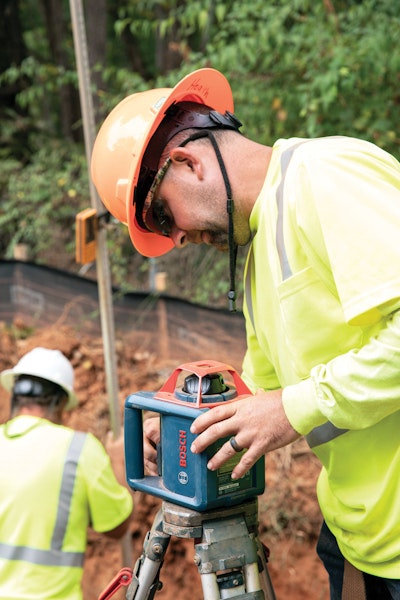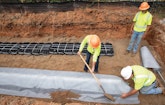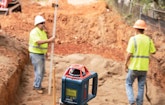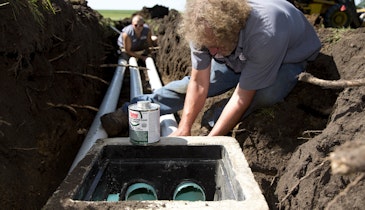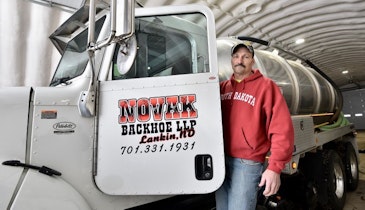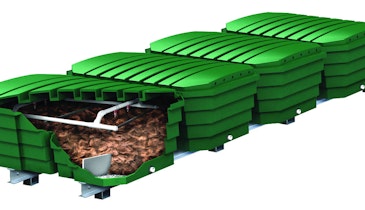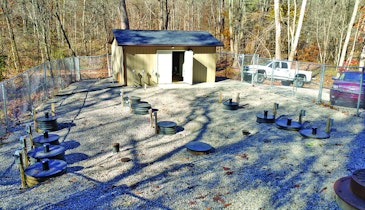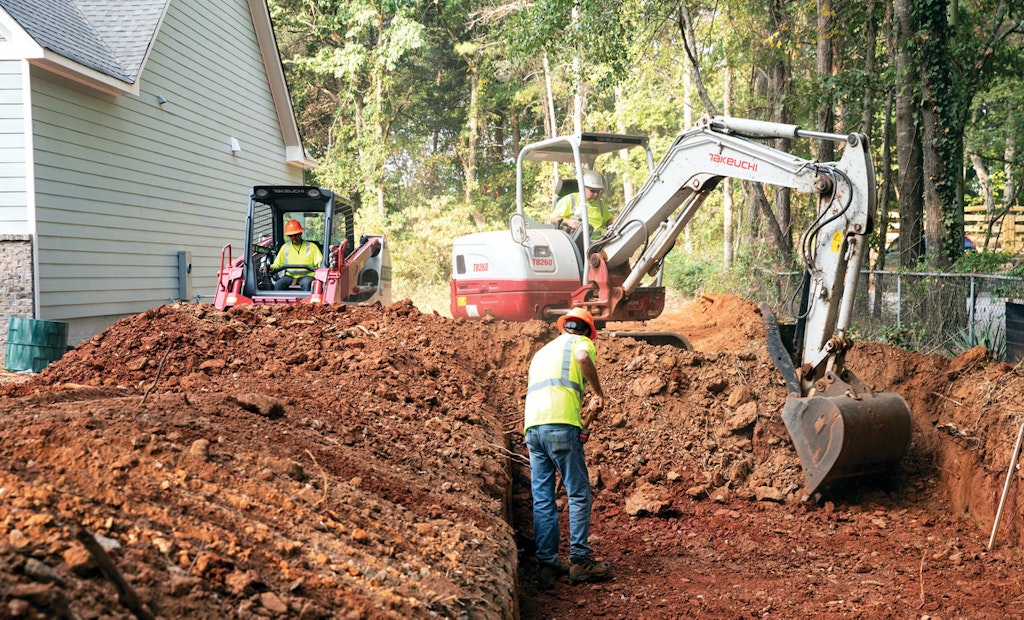
Harold Kilgore of Gravelator Systems uses a Takeuchi TB260 compact excavator to dig the Eljen drainfield, while Heath Kilgore moves the spoils with a Takeuchi TL12R2 compact track loader. The house and fence line are 30 feet apart. Laborer David Thompson shovels out stones. (Photos by Kaylinn Gilstrap)
A businessman sought to purchase a prime 0.39-acre lot on sprawling Lake Lanier in the northern region of Georgia, but the state Department of Health had approved it for only a one-bedroom cottage. The potential buyer wanted to build a three-bedroom home.
In addition, the Hall County Environmental Health Department wouldn’t issue a septic permit due to the extent of disturbed soils. Over the years, locals had dumped vegetative debris and fill on the lot and used it as a borrow pit.
The businessman consulted Harold Trip, owner of Premiere Residential Builders. Trip had built several homes for the customer and had worked previously with Harold Kilgore, owner of On-site Wastewater Consultants and Gravelator Systems in Carnesville, Georgia.
“The complexity of many projects today isn’t the install, it’s reaching that point,” Kilgore says. “Getting the county on board was the major hurdle for this job.” Eljen sand filter modules made the permit possible and the businessman bought the lot.
Checking the boxes
Steve James, Kilgore’s managing partner, met with Hall County regulators to learn what they required for this septic permit. “It was a two-step process,” James says. “The first was a Level IV soil evaluation.”
Kilgore hired William Taylor, a soil scientist with Beck, Taylor, & Beshara, then Kilgore excavated six test pits to determine the depth of the debris and fill and if the borrow pit had sufficient depth to avoid a rock ledge. Taylor’s report noted that “six borings in this small area exceed Level III boring density requirements,” and that the soil underneath the fill was suitable for use. The regulators accepted his conclusion.
The second requirement was a design showing the three-bedroom house, a driveway and the primary system with recovery area on the lot. Kilgore and Trip collaborated on the site plan.
“After determining the footprint of the three-bedroom house and onsite system, we placed the home on the west property setback line to provide the maximum work area on the east side for the tanks, force main and drainfield,” Kilgore says. “The 1,008-square-foot stone-and-pipe recovery field occupied the entire front yard. It’s shown on the plan but wasn’t installed.”
Hall County officials approved the septic permit. The overall process took seven months.
Site conditions
Soils are Cecil (deep, well-drained, moderately permeable soils like sandy loam) with a percolation rate of 60 minutes per inch.
System components
Kilgore designed the system to handle 450 gpd. Major components are:
- 1,500-gallon dual-compartment concrete septic tank (Nix Septic Tank Co.) with 4-inch effluent filter (Polylok) and risers (TUF-TITE)
- 1,000-gallon single-compartment concrete dose tank with 1/3 hp Model 253 effluent pump (Liberty Pumps)
- 40 feet of 1.5-inch Schedule 40 PVC force main
- 4-outlet distribution box (Polylok)
- 24 A-42 sand filter modules (Eljen)
- 25 cubic yards of ASTM C-33 sand from River Sand
- Installer Friendly Series Simplex control panel (SJE Rhombus)
System operation
All piping is PVC Schedule 40.
Wastewater gravity flows 13 feet through the 4-inch house lateral to the septic tank, then effluent drains to the dose tank. Its on-demand pump sends 75 gallons through a 1.5-inch force main 40 feet to the distribution box. Effluent then gravity flows to two 48-foot-long rows of modules in a 11-foot-wide trench. The rows, separated by 2 feet, each have a dozen 48- by 24- by 7-inch-high modules.
Effluent drips through a 4-inch perforated pipe above the treatment units. After the liquid passes through the interwoven plastic corrugated core and black geofabric, it discharges to 12 inches of ASTM C-33 washed sand over native soil.
Installation
The house was still under construction when Gravelator Systems installed the system. Kilgore coordinated with Trip for a 3- to 5-day window in which his team had the run of the lot. “Both construction crews would have clogged the narrow road to the property,” Kilgore says.
Once workers removed the debris on the lot and corrected the borrow pit, the installation went so smoothly that they finished in two days. One reason for the speed was Heath Kilgore’s template for drilling holes in the modules’ distribution pipe.
“My son took a 4-foot length of angle iron and drilled 1/2-inch holes in it,” Kilgore says. “He staggered the holes side to side in the 5 and 7 o’clock positions and spaced them 6 inches apart, then welded a handle on the edge of the angle iron. The template has increased our production 100%.”
On the second day, the new owner and his son arrived to see what an Eljen system looked like. Kilgore used the visit as an educational opportunity.
The state had approved Eljen’s equivalency factor to size the primary drainfield, but it still mandates recovery fields to be conventional stone and pipe. “Georgia regulators are living in the Stone Age regarding recovery,” Kilgore says. “We feel the lot would be more valuable had we installed a second Eljen system for recovery, especially when it is more cost-effective than 336 feet of gravel. It also would allow the owners to do more with their property.”
Maintenance
Gravelator holds the Technical Assistance Agreement. Twice a year, a technician downloads information from the control panel and checks for problems. The effluent filter is cleaned annually.
